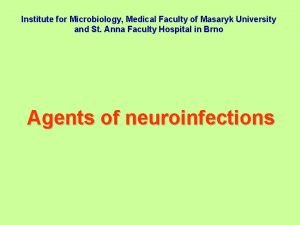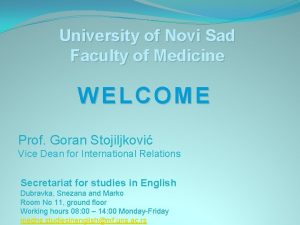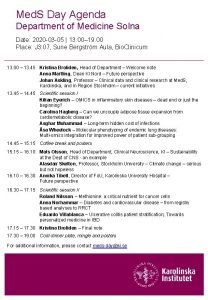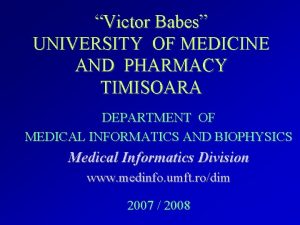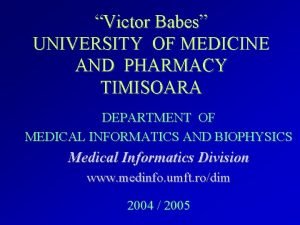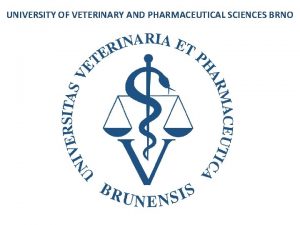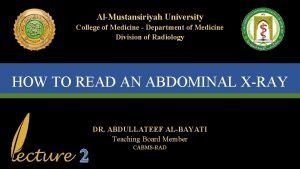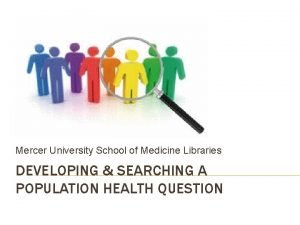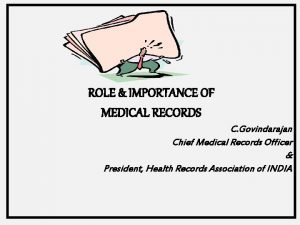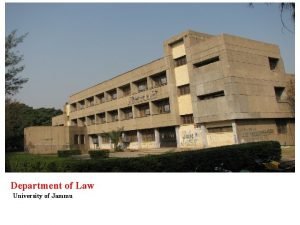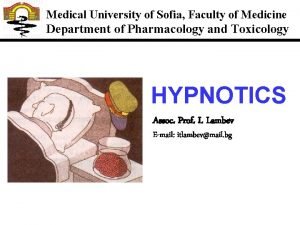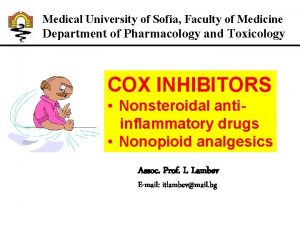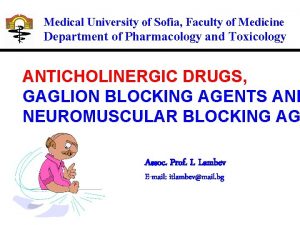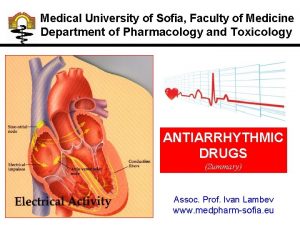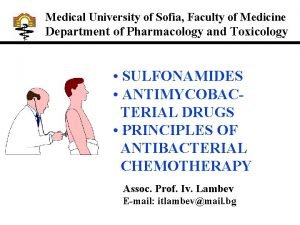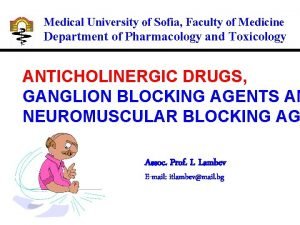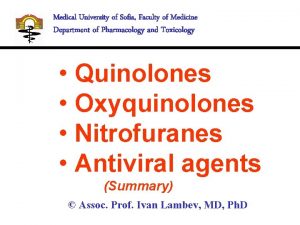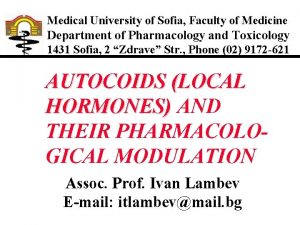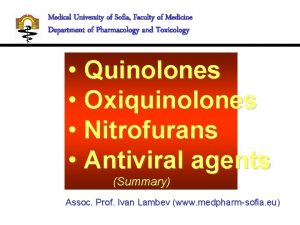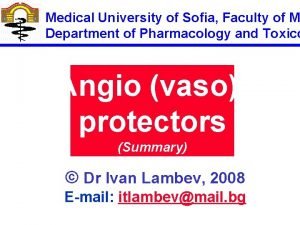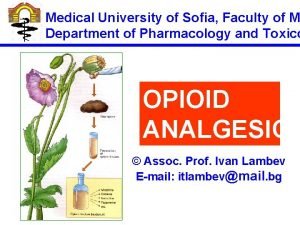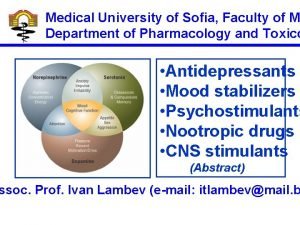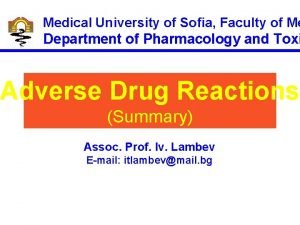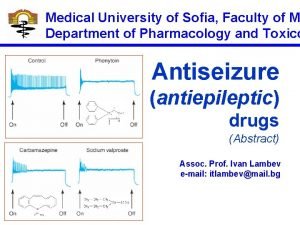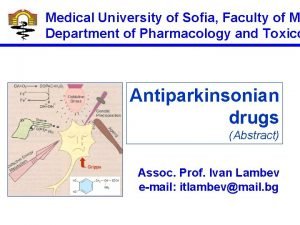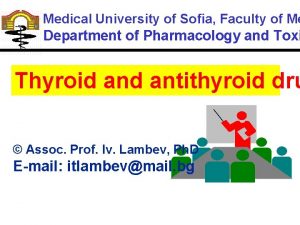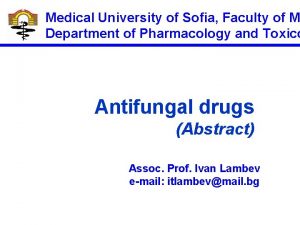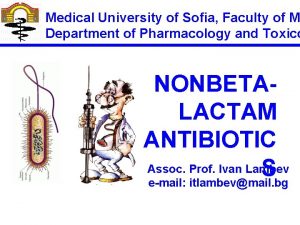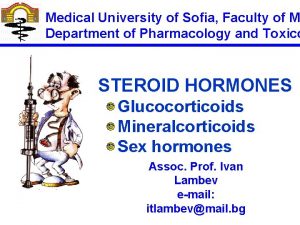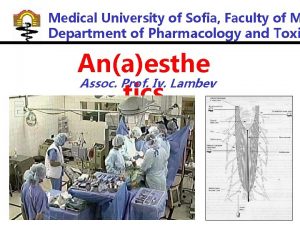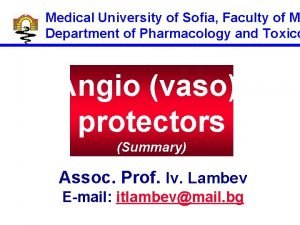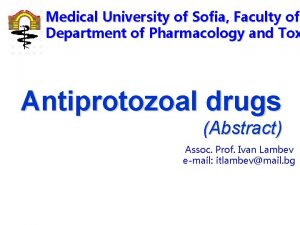Medical University of Sofia Faculty of Medicine Department












































































- Slides: 76

Medical University of Sofia, Faculty of Medicine Department of Pharmacology and Toxicology ANTICANCER DRUGS © Assoc. Prof. Ivan Lambev E-mail: itlambev@mail. bg

Possible causes of cancer Physical agents (radiation, GSM or injury) Chemicals (carcinogens, including smoking) Hereditary factors Effectiveness of immune system (virus infections: Ca collum uteri) Stress, > BMI, some drugs

Characteristics of cancer cells Uncontrolled proliferation Can be invasive Can metastasize Lack of function (lack of differentiation)

Normal cells • Growth is controlled by growth factors and growth inhibitory factors Cancer cells • Inactivation of tumor-suppressor genes • Activation of proto-oncogene

ANTICANCER TREATMENT surgery radiotherapy (irradiation) chemotherapy modificators of biological sustain therapy response

I. CLASSICAL II. ANTICANCER DRUGS Alkylating agents (alkylators) Antimetabolites Mitotic inhibitors Cytotoxic antibiotics Hormones and hormone antago Enzymes etc.

Mechanism of action and clinical use The majority of antineoplastic agents inhibit process of DNA synthesis within the cancer cells. Resting cells (those in the Go phase) are resistant to many anticancer drugs.

Action of cytotoxic agents on the cell cycle Cycle non-specific Phase specific Alkylators Antibiotics Antimetabolites Mitotic inhibitors

Precursors Methotrexate Pyrimidine Purine Ribonucleotides Mercaptopurine Hydroxyurea Deoxiribonucleotides Alkylators Cis-platin Antibiotics Sex sterioids Nitrosureas Mitotic inhibitors DNA Asparaginase RNA Asparagine Proteins


The sensitivity of a cancer to treatment depends on the growth fraction that is the fraction of cells undergoing mitosis at any time.

The fraction of cell division in Burkitt’s lymphoma is 100% and this tumor is very sensitive. In contrast the growth fraction represents less than 5% of cells in a carcinoma of the colon and this explains its resistance to chemotherapy.

However, metastases from colonic carcinoma, deposited in the liver and elsewhere initially, have a high growth fraction and are sensitive to chemotherapy, which is frequently given following surgical removal of primary tumor.

Different forms of cancer differ in their sensitivity to chemotherapy. The most responsive are rapidly proliferating tumors: lymphomas leukemias chorioncarcinoma testicular carcinoma

Solid tumors show a poor response: colorectal carcinomas adrenocortical carcinomas squamous cell bronchial carcinomas

An intermediate response is shown by other cancers, for example: bladder head and neck oаt cell bronchogenic carcinoma sex-related cancers of breast, ovary, endometrium, prostate

Treatment of cance Solid tumors – surgery or irradiation, plus CHEMOTHERAPY “Non-solid tumors” – CHEMOTHERAPY Metastases – CHEMOTHERAPY

Adverse effects of anticancer agents Limited selectivity (selectivity resides in damage to dividing cells). As a result general adverse effects are: • Myelotoxicity (decreased of leucocytes produce resistance to infection) • Hair loss

• Damage to GI tract (impaired wound healing) • Depression of growth • Nausea and vomiting (controlled with the antiemetics) • Carcinogenicity (in rare cases) • Reproductive toxicity (PRC: D/X) • Kidney damage • Hepatotoxicity

esistance to cytotoxic drug (primary or acquired) • Increased rate of synthesis of target enzy (dihydrofolate reductase and methotrexate • Increased repair of DNA (alkyllating agent • Insufficient activation of prodrug – cytarabine (does not undergo phospho • Multi Drug Resistans – increasing action o membrane efflux system (P 170, P 190) etc.

Strategy to avoid resistance Use 3 or 4 anticancer drugs together or in sequence, e. g. treatment of lymphomas: • COP treatment (COP – acrony – Cyclosphamide – Oncovin® (vincristine) – Prednisolone

Criteria for selecting of combina • Each drug should be an active antica drug its own right. • Each drug should be have a differen mechanism of action and target site the cancer cell (this will increase eff and reducing the resistance). • Each drug should be have a differen for any organ-specific toxicity.

Alkylating agen These drugs were developed from t sulfur mustard gases used in the 1 s trenches and which caused bone marrow suppression in addition to t respiratory toxicity. Replacement of the sulfur atom by nitrogen allowed to receive the first alkylating agents.

The important functional groups is the dichlor-ethyl-amine side-chain: CH 2 Cl R-N CH 2 Cl The dichlorethylamine chains are highly reactive and produce alkylating groups which bind covalently to sites within DNA such as N 7 of guanine.


First alkyllators are: Cyclophosphamide Chlorambucil

Cyclophosphamide and Chlorambucil are commonly used for Hodgkin’s and non-Hodgkin’s lymphoma, chronic lymphocytic leukemia. Cyclophosphamide is also used for immunosupression in non-malignant disorders (severe rheumatoid disorders, myasthenia gravis, multiple sclerosis). Busulfan: in chronic myeloid leukemia.

Cyclophosphamide is a prodrug. One of its metabolites is acrolein. Acrolein causes bladder toxicity with haemorrhagic cystitis which can be prevent by prior treatment with Mesna. Bladder cancer may develop years after cyclophosphamide chemotherapy.

Nitrosureas (the other alkyllators) inhibit the synthesis of DNA, RNA and proteins. Carmustine crosses BBB. It is used for brain tumors. Carmustine and Lomustine are used for treatment of Hodgkin’s lymphoma.

Cis-platin binds to DNA and proteins. It has made a significant impact on treatment of testicular teratoma and ovarian tumors. It has a long t 1/2 (72 h) due to extensive protein binding and slow renal elimination. • Renal toxicity is a major problem. Severe nausea and vomiting are often troublesome too. PRC: D.

Antimetabolites – produce lethal synthes A number of useful chemotherapeutic agents have produced by simple modifications to the structures of normal purine and pyrimidine bases.

a) Analogue of pyrimidine • 5 -Fluorouracil (5 -FU®: i. v. ) – used for treatm carcinoma of stomach, colon, rectum, breast and p • Xeloda® (p. o. ) – used in colorectal carcinoma. It is a prodrug of 5 -FU with very high selectivity • Cytarabine: used in acute myeloid leukemias

• Gemcitabine inhibits DNA polymerase and impairs DNA synthesis. Its is suitable for treatment of chronic lymphocytic leukemia in patients who have not responded to alkylating agent regimen. b) Analogues of purine • Mercaptopurine (6 -MP): in childhood acute l • Thioguanine (6 -TG): in childhood acute leuke • Azathioprine suppresses T-lymphocytes: used in organ transplantation and rheumatoid a

c) Folic acid antagonists Folic acid in its reduced form (THF tetrahydrofolic acid) is essential for synthesis of the purine ring system. During these reactions THF is oxidized to dihydrofolic acid which has to be reduced by dihydrifolate reductase back. Methotrexate inhibits dihydrofolate reductase and blocks purine and thymidylate synthesis.

Folic acid Methotrexate

Methotrexate is given for treatment of: • acute lymphoblastic leukemia • non-Hodgkin’s lymphomas • chorionepithelioma • non-malignant disorders (such as psoriasis).

Adverse effects of methotrexate • Vasculitis • Arachnoiditis • Pharyngitis, pneumonitis • Cystitis PRC: D • Vomiting • Hepatotoxicity • Renal dysfunction

Mitotic inhibitors Vinca alkaloids Podophyllin derivatives Taxans (taxoids) They have cycle and phase specific action on

Vinca alkaloids are complex natural chemicals isolated from the periwinkle plant (Vinca rosea). • Vinblastine • Vincristine, Vinorelbine þThey bind to tubulin and produce metaphase arrest. þThey use for acute leukemia.

Vinblastine Vincristine

Podophyllin derivatives May apple (Podophyllum peltatum - India, USA) Podophyllin Epipodophyllotoxin Etoposide

Etoposide • Inhibits mitosis • Acts in late S- or early G 2 -phases • Treatment of lymphoma; lung, testicular, bladder and prostate carcinoma

Taxans (toxoids) Inhibit the depolymerization of tubulin and block mitosis. • Docetaxel in breast cancer • Paclitaxel

Cytotoxic antibiotics • Inhibit DNA replication.

Daunorubicin Epirubicin Doxorubicin Idarubicin

• Other antibiotics Mitomycin – in cancer of bladder (locally) Bleomycin in: – tetsicular carcinoma – melanomas, sarcomas – squamous cell carcinomas

Hormones and hormone antagonists Some cancer arise from cell lines w steroid receptors. Steroid hormone cause remissions in certain types cancer. They usually do not eradic the disease, but can alleviate symptoms for a long period and do not depress the bone marrow.

Glucocorticoids suppress lymphocyte mitosis and are used in combination with cytotoxic agents in treating of lymphomas, myeloma and to induce a remission in acute lymphoblastic leukemia.

Glucocorticoids are also helpful in reducing oedema around a tumor. They have antiemetic activity too. • Hydrocortisone, Prednisone • Dexamethasone, Prednisolone

Estrogens suppress prostate cancer cells both locally and metastases, and provide symptomatic improvment. Gynecomastia is a common side-effect. • Fosfestrol • Polyestradiol phosphate ® (Honvan )

Progestins suppress endometrial cancer cells and lung secondaris: • Gestonorone • Medroxyprogesterone

Androgens are used in treating of carcinoma ovarii and uteri • Drostanolon • Testosterone

Androgen antagonists suppress prostate cancer cells. Unwanted effects include: gynecomastia, decreased spermatogenesis, decreased libido. • Cyproterone • Flutamide

p. o. i. m. Cyproterone (Androcur®) - antiaphrodisiacum too -

Inhibitors of alpha-reductase (e. g. Finasteride) • Alfa-reductase converts testosterone in more active dihydrotestosterone. • Finasteride is useful orally in the treatment of benign prostatatic hyperplasia. Unlabeled use: Adjuvant monotherapy after radical prostatectomy in the treatment of prostatic cancer.

Estrogen antagonists (e. g. Tamoxifen - p. o. ) suppress breast cancer cells. Transisomer of Tamoxifen binds competitively to estrogen receptors. Adverse effects include hot flushes and amenorrhoea in premenopausal women and vaginal bleeding in postmenopausal women.

Aromatase inhibitors • Aminoglutethimide (p. o. ) • Formestane (i. m. ) - They inhibit aromatase and block conversion of androgens to estrogens. - Inhibition of aromatase reduces estrogen production in adipose tissue, skin, muscle and liver of postmenopausal women (because ovarian aromatase is resistant to such inhibition).

Aromatase is also present in the cells of two-thirds of breast carcinomas and about 80% of these tumors are estrogendependent. Aromatase inhibitors are used in postmenopausal women with advanced breast carcinoma. Side effects include symptoms of estrogen withdrawal, e. g. headache, hot flushes, and lethargy; dyspepsia, nausea, alopecia, skin rash, hypotension, tachycardia.


Gonadotropin releasing hormone agonists (Gn. RHAs) Continuous daily administration of Gn. RHAs results in suppression of testicular and ovarian steroidogenesis due to decreased levels of LH and FSH with subsequent decrease in testosterone (in man) or estrogens (in women).

Gonadotropin releasing hormone agonists: • Goserelin - 3. 6 mg/30 days s. c. • Leuprolide Indications: - palliative treatment of advanced prostatic carcinoma - endometriosis

Enzymes (Asparaginase and other inhibitors of protein synthesis Asparaginase removes circulating asparagine which essential for canc cells. It has been given by i. v. infusio in acute lymphoblastic leukemia. It causes sever toxicity to liver and pancreas, anaphylactic reactions too

II. MODIFICATORS OF BIOLOGICAL RESPON The immune system probably contributes to the final removal of residual malignant cells, and most cytotoxic anticancer agents compromise immunoresponsiveness. Many modificators of biological response act really as immunostimulants.

Cytokines – peptide regulators of inflammatory and immune reactions • Interleukins, interferons, colony-stimulating factors, tumour necrosis factors. . .

Aldesleukin (IL-2) Produced by T-lymphocytes which activate cytotoxic killer cells. Received by recombinant DNA technology. IL-2 has been given by i. v. infusion in patients with metastatic renal carcinoma. It can produce hypotension, edema, fluelike symptoms, vomiting, anaemia.

Interferons (alpha, beta, gamma) are glycoproteins produced as part of the natural host defenses to virus infections. They have antiviral activity, immunoregulatory function, reduce multiplication of cancer cells. Interferon alfa-2 b (Intron® A) – in: • chronic hepatitis, hairy cell leukemia • AIDS-related Kaposi’s sarcoma • renal carcinoma

Colony-stimulating factors (CSFs) • are used in special cancer therapy centers to reduce the severity and duration of the neutropenia induced by cytotoxic anticancer chemotherapy; • used in aplastic anaemia; • used in anaemia in AIDS.

Filgrastim (Recombinant Human Granulocyte Colony-Stimulating Factor r. Hu. G-CSF) Molgramostim (Recombinant Human Granulocyte. Macrophage Colony-Stimulating Factor - r. Hu. GM-CSF)

Blockers of cell transduction signalling a) Antiangiogenic drugs (used in colorectal cancer)

b) Monoclonal antibodies – blockers of receptors for growth fa TRASTUZUMAB (Herceptin®): i. v. inf. RITUXIMAB (Mab. Thera®) – NHL

c) Inhibitors of tyrosinekin Imatinib ® (Glivec ) – – for oral treatment of chronic myeloid leukemias

Vaccines • BCG – locally in bladder cancer ® • Silgard : Ca colli utrei (HPV – type 1 ® Immunotherapeuticum Immune stimulation • Levamisole (out of date) • Polyerga® (improves quality of life)

III. SUSTAIN THERAPY IN ONCOLOGY • Analgesics • Antiemetics • Bisphonate derivatives • Etc.


Emetogenic activity Cisplatin Carmustine Cyclophosphamide Mitomycin C L-Asparginase Fluorouracil Methotrexate Etoposide Vincristine Ondansetron (Zofran®)

Bisphonate derivative - inhibit bone resorption via action on osteoclasts • Alendronate • Clodronate • Ibandronate • Pamidronate • Hypercalcemia, associated with maligna • Osteolytic bone lesions in multiple myeloma or metastatic breast cancer
 Hubert kairuki memorial university faculty of medicine
Hubert kairuki memorial university faculty of medicine Hyperparathyreosis
Hyperparathyreosis King abdulaziz university faculty of medicine
King abdulaziz university faculty of medicine Territorial matrix vs interterritorial matrix
Territorial matrix vs interterritorial matrix Faculty of veterinary medicine cairo university logo
Faculty of veterinary medicine cairo university logo Hacettepe university faculty of medicine
Hacettepe university faculty of medicine Faculty of veterinary medicine - university of tehran
Faculty of veterinary medicine - university of tehran Semmelweis university faculty of medicine
Semmelweis university faculty of medicine Faculty of veterinary medicine cairo university
Faculty of veterinary medicine cairo university Cairo university faculty of veterinary medicine
Cairo university faculty of veterinary medicine Masaryk university medical faculty
Masaryk university medical faculty Chronic meningitis
Chronic meningitis Faculty of medicine nursing and health sciences
Faculty of medicine nursing and health sciences Mcgill medicine supporting documents
Mcgill medicine supporting documents Pubh4401
Pubh4401 Emory clinic - school of medicine faculty
Emory clinic - school of medicine faculty Nit calicut chemistry department
Nit calicut chemistry department E-learning sofia university
E-learning sofia university University of chemical technology and metallurgy sofia
University of chemical technology and metallurgy sofia Technical university sofia
Technical university sofia Technical university of sofia
Technical university of sofia Medical faculty in novi sad dean
Medical faculty in novi sad dean University of split faculty of maritime studies
University of split faculty of maritime studies Bridgeport engineering department
Bridgeport engineering department University of bridgeport computer engineering
University of bridgeport computer engineering Florida state university masters in computer science
Florida state university masters in computer science Mendel university - faculty of business and economics
Mendel university - faculty of business and economics Singularity university faculty
Singularity university faculty Feup university of porto
Feup university of porto Charles university humanities
Charles university humanities Faculty of law of the university of zagreb
Faculty of law of the university of zagreb University of montenegro faculty of law
University of montenegro faculty of law University of kragujevac faculty of technical sciences
University of kragujevac faculty of technical sciences University of cologne faculty of management
University of cologne faculty of management Leading university cse faculty members
Leading university cse faculty members Brown university computer science faculty
Brown university computer science faculty Ulfg2
Ulfg2 Faculty of education york university
Faculty of education york university Faculty of economics and business debrecen
Faculty of economics and business debrecen Clemson ece lab manual
Clemson ece lab manual Faculty of mechanical engineering thammasat university
Faculty of mechanical engineering thammasat university Mendel university faculty of business and economics
Mendel university faculty of business and economics Faculty of public health mahidol university
Faculty of public health mahidol university Thin and thick smear
Thin and thick smear Faculty of education khon kaen university
Faculty of education khon kaen university Communication arts chulalongkorn university
Communication arts chulalongkorn university Department of medicine solna
Department of medicine solna Meritus primary care
Meritus primary care Babesuniversity
Babesuniversity Lincoln memorial university college of veterinary medicine
Lincoln memorial university college of veterinary medicine King faisal university college of medicine
King faisal university college of medicine King saud university college of medicine
King saud university college of medicine Prodofol
Prodofol Uw integrative medicine
Uw integrative medicine Victor babeş university of medicine and pharmacy
Victor babeş university of medicine and pharmacy Victor babes university of medicine and pharmacy
Victor babes university of medicine and pharmacy King saud university college of medicine
King saud university college of medicine Brno veterinary
Brno veterinary Slu family medicine residency
Slu family medicine residency Al mustansiriya university college of medicine
Al mustansiriya university college of medicine Midwestern university college of dental medicine
Midwestern university college of dental medicine Seoul university medical school
Seoul university medical school Ukcom curriculum
Ukcom curriculum University of new mexico internal medicine residency
University of new mexico internal medicine residency Teala
Teala University of arizona emergency medicine
University of arizona emergency medicine Importance of medical records department
Importance of medical records department Medical education and drugs department
Medical education and drugs department Department of law university of jammu
Department of law university of jammu Department of geology university of dhaka
Department of geology university of dhaka University of padova psychology
University of padova psychology University of bridgeport it department
University of bridgeport it department University of iowa math department
University of iowa math department Sputonik v
Sputonik v Psychology texas state
Psychology texas state Department of information engineering university of padova
Department of information engineering university of padova Information engineering padova
Information engineering padova











